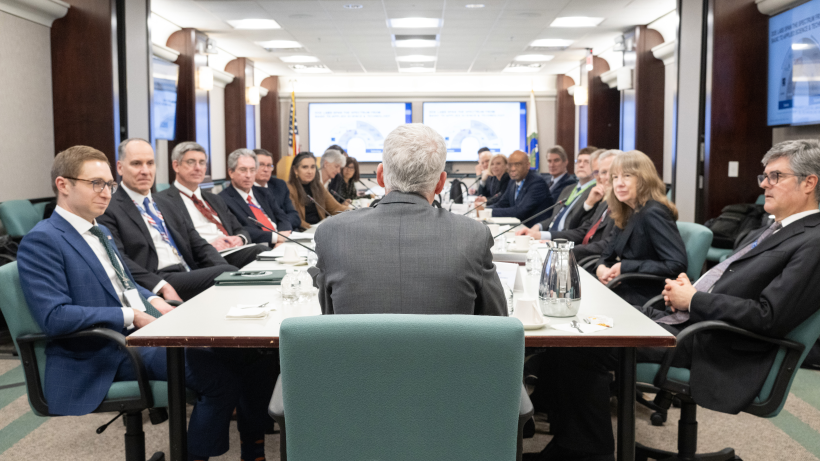DOE Eases Regulation of National Labs

Energy Secretary Chris Wright meets with all 17 national lab directors in April.
Donica Payne / DOE
Energy Secretary Chris Wright issued an order
However, the top Democratic appropriators for DOE have expressed concern that the order reduces oversight of major construction projects and could lead to cost overruns and project delays. They have asked
The order reduces the number of projects that will be subjected to DOE’s review process
John Wagner, director of Idaho National Lab and chair of the National Laboratory Directors’ Council, told FYI that the lab directors proposed $300 million as the threshold for projects that are sufficiently complex to require more oversight. “[The DOE review process] adds a variety of approvals and additional rigor into projects that do come at a time and cost expense. That makes sense for very big, complicated projects and adds less value for small, more routine projects,” Wagner said, contrasting the complexity of building a new spallation neutron source with the routine work of building new office space.
“Over time, $50 million doesn’t buy what it used to. And we decided for projects roughly under $300 million, the cost wasn’t worth the benefit,” he added.
Projects between $300 million and $1 billion will use a “graded approach” to the review process based on the details of the project, Wagner said, though DOE and the labs are still working out the exact rubric for that approach.
Wagner said some labs had been looking to ease these regulations since before he became the director of Idaho National Lab in 2020, including around the beginning of the first Trump administration. Similar areas of improvement were identified then, but progress “to this degree” was not achieved, he added.
“What’s really encouraging right now is how quickly the secretary acted on these issues,” Wagner said.
DOE put out a press release
Meanwhile, the top Democratic appropriators for DOE, Sen. Patty Murray (D-WA) and Rep. Marcy Kaptur (D-OH), have cautioned that inadequate supervision over past DOE projects led to “significant delays and project overruns.”
“The department’s own tracking confirms the risk,” Murray and Kaptur wrote in a letter to GAO, adding that 53% of the department’s total project portfolio, representing over $24 billion, is not meeting targets for cost or time efficiency. “Without sufficient oversight, there is a higher likelihood that projects will not meet their cost estimates or will fail to be completed within the allocated timelines,” the letter states.
Other reforms
Wright’s order also removes some current DOE requirements for subcontractor construction companies regarding workers’ exposure to potentially dangerous materials. These considerations may not be applicable to all DOE construction projects, such as an office building, but the contractors must still meet those requirements, Wagner said. Typically, contractors are not as familiar with these additional requirements, making them less inclined to take on the project, Wagner added.
Removing those requirements will “increase the number of construction companies that can bid on work at LANL and provide a more competitive bidding process that will assist in lowering the costs of construction,” Mason said in the DOE press release. The order states that the labs will instead implement a “tailored, graded approach” to meet legal requirements for worker safety and health and notes that a similar framework has been used by the National Nuclear Security Administration.
The order also removes some oversight of labs’ employee compensation plans, including how much the lab will spend on increases, bonuses, relocation, and retention. Under the previous process, those plans required annual reviews and any changes were subject to DOE approval. Wagner said that process was “not adding additional serious value” because the existing legal requirements are sufficient.
“This is not an effort to really make dramatic differences in how we compensate our employees,” Wagner said. “It’s an effort to take the bureaucracy and the requirements and the approvals and all these things, additional overlay of requirements that slows us down.”
In the DOE press release, Jefferson Lab Director Kimberly Sawyer said revising the compensation clauses “could result in up to 40% time savings in onboarding key personnel” and gives the lab “the flexibility needed to attract and retain top-tier talent.”
The order also directs DOE to assess the benefits and risks of removing construction labor agreement provisions from national lab contracts. The order notes that this evaluation should consider risks such as increased potential for labor strikes and local community concerns, though Wagner noted, “There is no interest in not paying good wages or not using organized labor or anything like that.”
The original model of the national labs’ managing and operating contracts gave them more flexibility to determine how to execute on the department’s mission, Wagner said. “They didn’t tell us how to do it, just, ‘Here’s what we want done. Here’s the budget, here’s the boundary conditions, cost, schedule, scope: Execute.’ Over time, contract requirements started creeping in that constrained how we do things for various reasons. Sometimes for good reasons, but those reasons are no longer relevant.”


